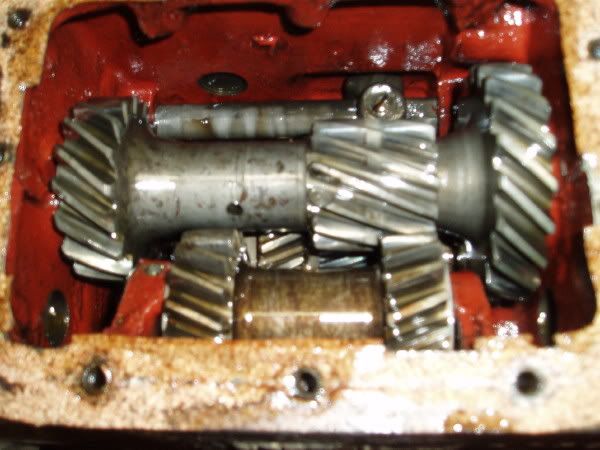It's time to give my father a little credit. While I was cutting, welding and grinding, my father devoted himself to the mechanicals.
Transmission first. Just to be on the safe side, he took the sump off the transmission to check the internals. Sure enough, the cluster gear had most of a tooth missing from first. Alan Wall had a good second-hand gear, so Dad stripped and rebuilt the gearbox.

Oops. Focus.
I asked the previous owner whether the gearbox made any noises in first gear, and he said it was perfectly quiet . . .
Dad stripped the generator down, trued up the commutator, lubed the bearings, bedded the brushes in, and reassembled it. And did the same to the starter motor as to the generator.
And rebuilt the fuel pump, including a neat trick with valve grinding paste and the fuel bowl to grind down a distorted gasket sealing face because the bail arm had been over-tightened. The vacuum section was a total mess. Rust, sludge, ooze, corrosion, you name it.
And pulled the carburettor to pieces, and lapped the faces of the air horn and main body until they were both flat. He found that the throttle butterfly was loose, and Loctited and staked the screws just to be sure.
I got to work on the distributor, but it was in very good condition anyway.
If you’ve owned a grey-engined Holden long enough, you’ll know what happens when the Welch plug in the back of the block rusts through. With the motor out, now was the time to take some preventative action. I punched the plug through, turned it around and levered it out. And there was the normal amount of mud behind number six cylinder. What fun a Gerni is. Then enough reassembly to set the motor and gearbox up on axle stands and start it up.
There’s a Woody Allen movie where the hero discovers a 200- or 300-year-old VW in a cave underground, and he turns the key and it starts. I wish. I’ve been told that there are some Holden engines which start immediately after a long storage period. This was not one of them. It woke up slowly, one cylinder at a time, and took maybe a quarter hour before it would idle. Despite its crappy state of tune, it didn’t rattle, didn’t leak oil, and didn’t blow smoke. So perhaps some potential . . .
The front suspension was next. The previous owner had told me he could never get the front wheel alignment right. When Dad disassembled the front suspension, the reason became clear. The right hand lower control arm shaft had come loose in the crossmember and had enlarged the hole maybe 1/8”. Repair. Do not replace. It sounds nuts, but I set to work on the crossmember with Mister MIG and a file, to restore the holes to the specified diameter (finally achieved by starting the shaft into the crossmember with a large hammer). The shaft tightened into place with >40 and <250 ft.lbs torque, as specified. But I noticed that the FC lower control arm shaft inner threads are straight, whereas in an HR they’re tapered, which is much more tolerant of a loose initial fit.
The front springs had broken coils.
The car came with a large box of steering knuckle supports, steering knuckles and king pins, and my father amused himself by selecting parts until he achieved a good, close fit.
The steering box was essentially shot. The case-hardening had gone off the worm shaft and ball-nut. In years gone by, if I needed a good steering column, I’d have gone down to Holton Spares in Dee Why, and Steve Williams would have let me go through his stock of steering boxes until I found a good one. But that was about 20 years ago.
Forum to the rescue. Unbelievable! There was an ad for FC steering column and front suspension, lower Hunter Valley. The donor car was a low-mileage FC. On disassembly, the steering box internals were in perfect order. You beauty. And the front suspension yielded a good pair of springs.
FC gearshift tubes have only two weak points, it seems: the top, where the gearstick engages the roller; and the bottom, where the lower lever bolts on. The original gearshift tube had broken at the bottom, which led to the Speco floorshift conversion; while the Hunter Valley gearshift tube had broken at the top. I chose to repair the original, as it was just the brazing for the lower lever which had broken.
More to come later.



